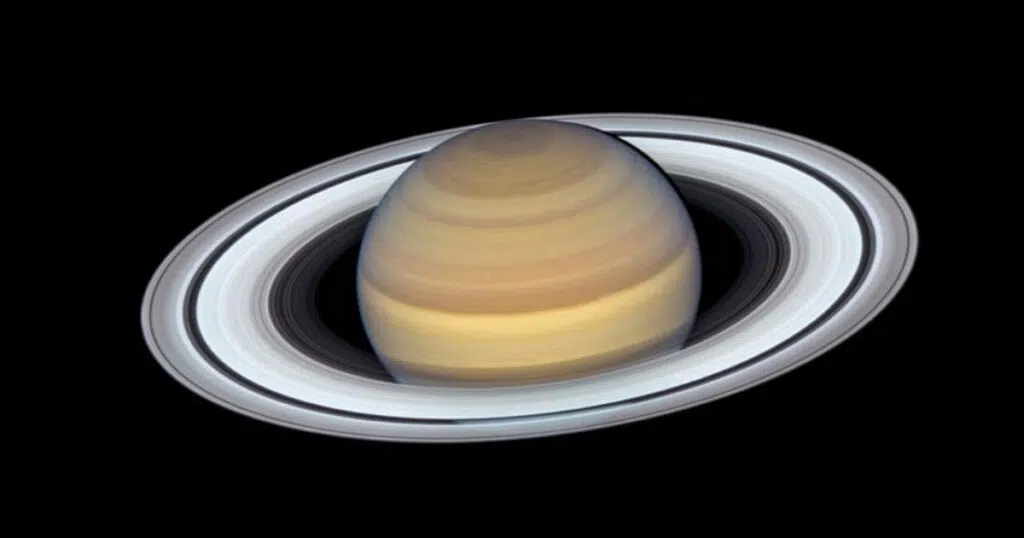
Solving the mysteries of Saturn – and those runaway comets
Of all the questions scientists have about our solar system, three have remained unanswered for generations — how did Saturn end up tilted, where did Saturn’s rings come from, and why do so many comets that originate from the far reaches of our solar system never end up coming back after Earth fly-bys?
To explain the mysteries circling Saturn, researchers in the September 15 edition of the journal Science suggest a another moon named Chrysalis may have participated in the gravitational tug of war between Saturn, its moon Titan and nearby Neptune that left the gas giant permanently leaning 27 degrees off its axis — and left Chrysalis ripped apart, its remnants to become the rings that circle the planet.
If any dinosaurs had had amazingly sharp eyesight and could see Saturn in the night sky, they likely would have seen the planet without rings. That’s because Saturn’s rings appear relatively young — created about 150 million years ago — when compared to Earth’s event timeline. That tilt is too large to have formed when Saturn did or to be the result of collisions knocking the planet over.
Planetary scientists have conjectured Saturn’s tilt is related to Neptune, because of a coincidence in timing between the way the two planets move. Both Saturn and Neptune wobble like a spinning top. It’s assumed that when Saturn formed, its spin axis was close to straight up and down.
The periods of the planets’ wobbles are almost the same, a phenomenon known as resonance. Scientists suspected gravity from Saturn’s moons — especially the largest moon, Titan — helped the planetary wobbles line up. But not enough was known about Saturn’s internal structure to prove the two timings were related.
Study researchers used precision measurements of Saturn’s gravitational field from the Cassini spacecraft, which fell into Saturn in 2017 after 13 years orbiting the gas giant, to calculate details of its internal features. The team was able to figure out Saturn’s moment of inertia, a measure of how much force is needed to tip the planet over, and determined Saturn’s moment of inertia is close to what it would be if its spin were in perfect resonance with Neptune’s orbit.
After considering a variety of explanations, Wisdom and colleagues realized that another moon would have helped Titan bring Saturn and Neptune into resonance by adding its own gravitational pull. Titan drifted away from Saturn until its orbit synced up with that of the smaller Chrysalis. Titan’s enhanced gravitational forces sent the smaller moon on a doomed course in which it grazed Saturn’s cloud tops before being crushed and ground up to the become the gas giants iconic rings.
“It’s a scenario that explains two or three different things that were previously not thought to be related,” said study coauthor Jack Wisdom, a planetary scientist at MIT. “The rings are related to the tilt, who would ever have guessed that?”
The small moon’s name, Chrysalis, was inspired by the moon’s spectacular ending, Wisdom said.
“A chrysalis is a cocoon of a butterfly…the satellite Chrysalis was dormant for 4.5 billion years, presumably,” he added. “Then suddenly the rings of Saturn emerged from it.”
One type of celestial visitor that scientists have noticed emerge for Earth fly-bys — and then are never seen again — are so-called long-period comets that are believed to originate in the Oort cloud, a sphere of icy objects at the fringe of our solar system. Their disappearances have been a mystery, since, even though their drawn-out orbits around the solar system may take 200 years or so to complete, conventional thinking says they’re expected to return for us to see again.
But, it turns out comets from the solar system’s frozen depths often don’t survive their initial encounter with the sun. Now, in a study submitted August 8 to arXiv.org, astronomer David Jewitt argues the ices balls don’t simply evaporate, as many scientists previously thought. Because of internal forces energized by the sun, the comets end up spinning so fast, they break apart.
“These things are stable out there in the Oort cloud where nothing ever happens. When they come toward the sun, they heat up, all hell breaks loose, and they fall apart,” Jewitt says.
In the 1950s, Dutch astronomer Jan Oort first proposed the the existence of some sort of cloud as a comet reservoir. He also saw many of cloud comets that came near Earth were first-timers, not return visitors.
One widely accepted possibility was that the comets die by sublimating all of their water away as they near the heat of the sun — although that didn’t fit with observations that comets seemed to physically break apart into smaller pieces.
“The disintegrations are really hard to observe because they’re unpredictable, and they happen quickly,” Jewitt said.
So, Jewitt turned to historical observations of long-period comets that came close to the sun since the year 2000. He selected those comets with water vapor production that had been indirectly measured by an instrument called SWAN on NASA’s SOHO spacecraft, to see how quickly the comets were losing mass. He also picked out comets with movements deviating from their orbits around the sun, and also had been measured. Such movements, Jewitt explained, are signs of water vapor jets pushing the comet around.
Jewitt expected that the most active comets would disintegrate fastest, but he found the opposite: the least active comets with the smallest, dirty snowball cores were the most at risk of falling apart.
“Basically, being a small nucleus near the sun causes you to die,” Jewitt says. “The question is, why?”
It wasn’t that the comets were torn apart by the sun’s gravity, because they didn’t get close enough for that. And sublimating didn’t match the observations. The comets are also unlikely to collide with anything else in the vastness of space and break apart, nor would they build up so much internal pressure they would explode, like a hand grenade, Jewitt said.
The best remaining explanation of the demise of so many long-period comets is rotational breakup, Jewitt said. As a comet nears the sun and its water heats enough to sublimate, jets of water vapor form, causing the comet’s core to spin. Smaller cores end up spinning faster.
“It just spins faster and faster, until it doesn’t have enough tensile strength to hold together,” Jewitt said. “I’m pretty sure that’s what’s happening.”



